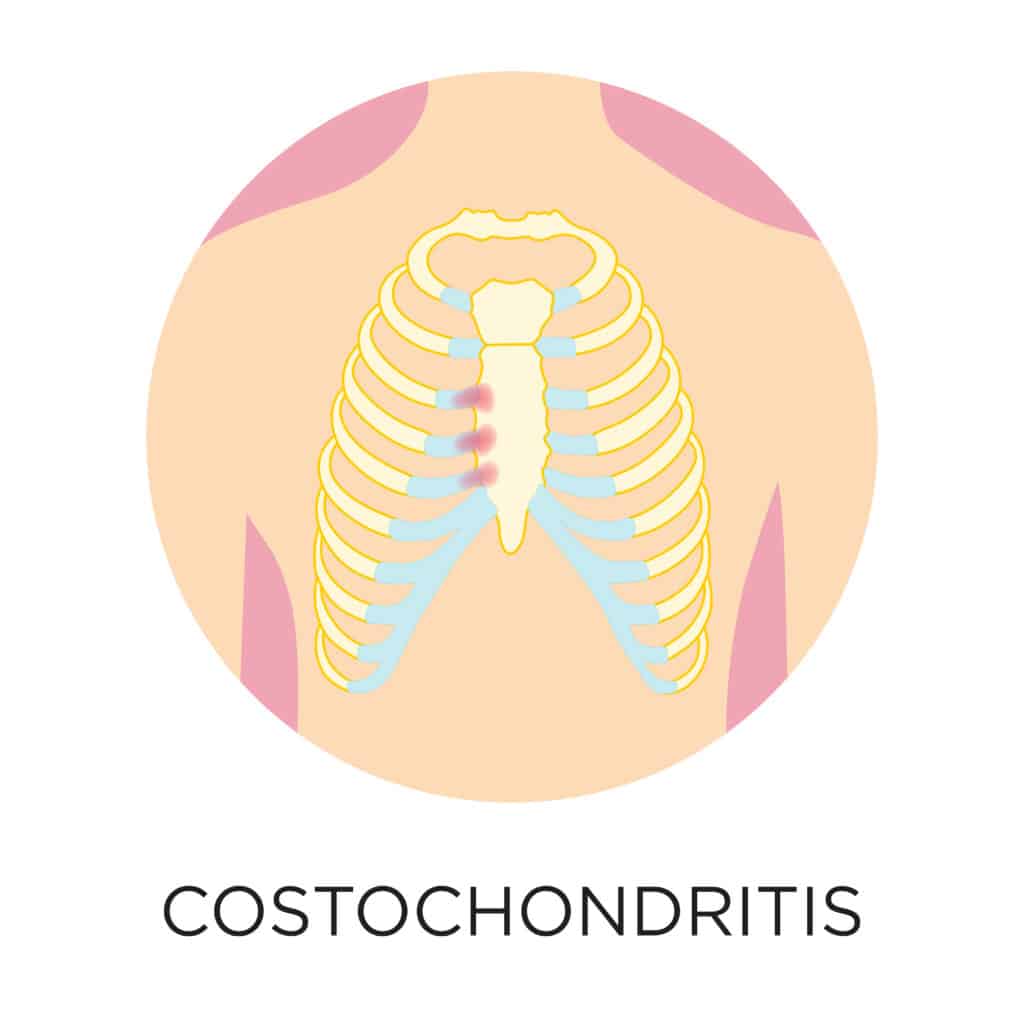Costochondritis – Symptoms, Causes, and Treatment Options
Costochondritis is an inflammation of the cartilage that connects your ribs to your breastbone (sternum). It often causes sharp or aching chest pain, which can feel similar to heart-related pain. The hallmark symptom is tenderness and discomfort in the chest wall, especially when you press on the affected area or move your upper body.
Many people with costochondritis find relief and faster recovery with physiotherapy for costochondritis, which helps reduce pain and improve mobility, while massage for costochondritis can ease muscle tension in the chest and upper body. Nutrition for costochondritis supports healing by reducing inflammation and promoting overall wellness, and counselling for costochondritis can provide tools to manage the stress or anxiety that often comes with chronic pain. Together, these services offer a caring, well-rounded approach to feeling better and getting back to daily life.

Overview of Costochondritis
Costochondritis is a common but often misunderstood condition. It occurs when the costal cartilage—the flexible tissue that connects your ribs to your sternum—becomes inflamed. This inflammation leads to chest pain that may worsen with movement, deep breathing, or physical activity. Because the discomfort often mimics heart pain (angina), many people with costochondritis first seek emergency care, only to be reassured that the heart is not the cause.
How common is costochondritis?
Estimates suggest that up to 30% of people with chest pain in emergency departments may actually have costochondritis rather than a cardiac condition (Disla et al., 1994). While exact prevalence in the general population is uncertain, it is a recognized cause of musculoskeletal chest pain in both adults and children.
Impact on daily life
Although costochondritis is not life-threatening, its impact can be significant:
- Work: Sitting for long periods at a desk, repetitive lifting, or physical labor may worsen chest pain. This can reduce productivity and lead to missed days of work.
- Sports and activity: Athletes often find chest movements—throwing, swinging, or heavy breathing—trigger discomfort, limiting training and performance.
- Sleep: Lying on the affected side or shifting positions can disturb sleep, creating fatigue.
- Relationships and mental health: Because chest pain can cause anxiety about the heart, people often experience added stress, worry, and reduced quality of life.
How costochondritis is different from similar conditions
Unlike Tietze syndrome, which also causes chest pain but includes visible swelling of the cartilage, costochondritis does not produce noticeable swelling. This distinction is important for diagnosis and reassurance.
Symptoms of Costochondritis
The main symptom of costochondritis is chest pain that gets worse when you move, breathe deeply, or press on the area. The pain usually affects more than one rib, most often the upper ribs on the left side.
What are the main symptoms of costochondritis?
- Sharp, aching, or pressure-like chest pain that can spread to the back or stomach.
- Tenderness to touch at the junction where the rib meets the sternum.
- Pain that worsens with movement such as lifting, twisting, or coughing.
- Pain that may feel like a heart attack, but does not improve with rest or heart medication.
Severity and spectrum of symptoms
- For some, costochondritis feels like a dull ache that comes and goes.
- For others, it causes sharp, stabbing pain that interrupts daily life.
- Pain intensity can range from mild discomfort to episodes so severe they require an emergency room visit.
Functional impacts
- Work: Chest pain may flare up during repetitive tasks, keyboard use, or lifting.
- Sport: Activities such as weight training, tennis, or swimming often worsen symptoms.
- Sleep: Rolling over or lying on your chest can interrupt rest, leading to fatigue.
- Mood and mental health: Ongoing chest pain can trigger anxiety, depression, or fear of heart disease.
Red flag signs: When to seek medical help
It is important to distinguish costochondritis from serious conditions. Seek urgent care if you experience:
- Chest pain with shortness of breath, dizziness, or sweating.
- Pain that occurs with physical exertion and eases with rest (possible angina).
- A history of heart disease, diabetes, or major risk factors along with chest pain.
Causes and Risk Factors for Costochondritis
There is not always a clear cause, but several risk factors and triggers of costochondritis are known. These include physical strain, poor posture, and certain medical conditions.
What are the common causes of costochondritis?
- Repetitive strain: Lifting, pushing, or pulling heavy objects can irritate chest cartilage.
- Injury: A fall, car accident, or sports collision may inflame the rib cartilage.
- Respiratory illness: Persistent coughing from asthma, bronchitis, or infection puts stress on the chest wall.
- Arthritis: Conditions such as osteoarthritis or rheumatoid arthritis can involve the costal joints.
- Infections (rare): After chest surgery or in people with weakened immunity, infections may cause costochondritis.
Lifestyle and biomechanical risk factors
- Age: Most common in adults over 40, though it can occur at any age.
- Posture: Long hours of slouching or working at a computer can add stress to the chest wall.
- Occupation: Jobs involving heavy lifting, repetitive arm movements, or long sedentary shifts increase risk.
- Pregnancy: Hormonal and biomechanical changes may stress the ribcage.
- Obesity: Excess body weight can put additional pressure on joints and cartilage.
How costochondritis connects to other conditions
Costochondritis can sometimes appear alongside:
- Fibromyalgia, where widespread pain increases sensitivity.
- Ankylosing spondylitis or other inflammatory diseases.
Daily life consequences of these risk factors
Someone who works in construction may notice chest pain worsening with heavy lifting. A pregnant individual may feel discomfort when breathing deeply. Office workers with poor posture may experience a steady ache that builds through the day.
Diagnosis, Recovery, and Management of Costochondritis
Diagnosis of Costochondritis
Costochondritis is usually diagnosed through a physical examination and by ruling out more serious causes of chest pain. Because chest discomfort can signal heart disease or lung conditions, healthcare professionals take a careful and structured approach to diagnosis.
How do doctors test for costochondritis?
Doctors typically begin with a detailed medical history. They will ask about the onset, duration, and type of pain, as well as what activities make it better or worse. Patients are often asked if pain worsens with movement, deep breathing, or touch, which helps distinguish costochondritis from cardiac or gastrointestinal causes.
The physical exam is central to diagnosis. Doctors press on the costosternal junctions (where the ribs meet the sternum) to see if pain can be reproduced. Pain that increases with pressure on specific rib joints is highly suggestive of costochondritis.
In some cases, imaging tests such as chest X-rays, CT scans, or MRI may be used—not to confirm costochondritis, but to rule out other conditions such as fractures, tumors, or infections. Blood tests are sometimes ordered to check for infection or inflammatory markers if systemic disease is suspected.
How is costochondritis different from heart or lung pain?
- Heart pain (angina or heart attack): Typically triggered by exertion and relieved by rest or medication. Pain may radiate to the arm, neck, or jaw.
- Lung pain (pleurisy or pulmonary embolism): Often associated with breathing difficulty, cough, or fever.
- Costochondritis pain: Localized tenderness at the chest wall, worsens with pressing on the area, twisting, or deep breaths.
Identifying root causes
Practitioners also explore functional contributors: poor posture, repetitive lifting, respiratory illness, or arthritis. By identifying the root cause, they can tailor treatment to prevent recurrence. For example, if coughing from asthma is the trigger, addressing asthma may reduce future flare-ups.
Recovery and Prognosis of Costochondritis
Most people with costochondritis recover within weeks to months, but recovery times vary based on severity and underlying risk factors. While the condition is temporary, it can feel disruptive and raise anxiety due to its resemblance to heart-related pain.
How long does costochondritis usually take to heal?
- Mild cases: Often improve within 2–4 weeks with rest, posture adjustments, and over-the-counter medication.
- Moderate cases: May last 6–12 weeks, especially if repetitive strain, poor posture, or underlying illness continues.
- Severe or chronic cases: Can last 3–6 months or longer. Recurrence is possible if risk factors such as heavy lifting, poor ergonomics, or respiratory illness are not managed.
Decision pathway for recovery
- If your pain is mild and mainly linked to recent strain → self-care, posture correction, and rest may be enough.
- If your pain is moderate and persists beyond a few weeks → evaluation by a doctor and possibly physical therapy may be needed.
- If your pain is severe or mimics heart symptoms → urgent evaluation is required to rule out life-threatening conditions.
Return-to-work, sport, and lifestyle outcomes
- Work: Desk workers may return within days, provided posture is improved. Physically demanding jobs may require gradual return after 2–4 weeks.
- Sport: Light activity can resume within 2–3 weeks if pain is mild. High-impact sports or heavy lifting may need 6–8 weeks before safe return.
- Lifestyle: With proper management, long-term outcomes are excellent. Chronic recurrence is rare but more likely in individuals with arthritis or poor posture habits.
Risk of recurrence
While costochondritis is usually self-limiting, flare-ups can return, especially during times of stress, illness, or repetitive activity. Preventive strategies such as ergonomic corrections, stretching, and strength training can reduce recurrence risk.
Reference:
Reddy, P., Vemulapalli, K., & Orellana, J. (2021). Costochondritis. StatPearls [Internet]. Treasure Island (FL): StatPearls Publishing. Retrieved from: https://www.ncbi.nlm.nih.gov/books/NBK532931/
Management of Costochondritis
Costochondritis management focuses on reducing pain, improving mobility, and preventing future flare-ups. Treatment is usually conservative and tailored to individual needs.
What’s the best way to manage costochondritis at home?
- Posture correction: Avoid slouching, especially at desks. Keep your shoulders back and spine aligned.
- Heat or ice therapy: Apply a warm compress or ice pack for 15–20 minutes to reduce discomfort.
- Gentle activity: Rest is important, but complete inactivity can worsen stiffness. Light stretching and walking are encouraged.
- Pain relief: Over-the-counter medications (acetaminophen, ibuprofen) may be used under guidance.
Self-help & relief tips (step-by-step)
- Check your posture – Adjust your chair, computer, and phone habits to avoid hunching.
- Apply heat or ice – Use whichever feels more soothing, especially after activity.
- Try gentle stretches – Reach your arms back or across your chest slowly, holding for 15–20 seconds.
- Modify activities – Avoid heavy lifting or overhead reaching during flare-ups.
- Practice deep breathing – Prevent shallow breathing caused by chest pain by practicing slow, deep breaths.
Lifestyle and therapeutic approaches
- Physical therapy: Can teach stretches, chest mobility exercises, and strengthening routines to support recovery.
- Ergonomics: Adjusting desk setup, sleeping position, and lifting technique reduces strain on the chest wall.
- Core strength and flexibility: Strong abdominal and back muscles improve posture and reduce pressure on the chest.
- Stress management: Anxiety can amplify chest pain. Breathing techniques, meditation, or counseling may help.
- Community and support: Talking to others with musculoskeletal pain can normalize the experience and reduce worry.
Long-term prevention strategies
- If you are prone to flare-ups, adopting regular posture breaks, gentle stretching, and core-strengthening exercises can help prevent recurrence.
- If you have arthritis or fibromyalgia, managing the underlying condition can reduce chest wall pain episodes.
- If coughing is a trigger, working with your doctor to control asthma, allergies, or respiratory infections is key.
Multidisciplinary Care for Costochondritis at CARESPACE
At CARESPACE, costochondritis is treated with a team-based, multidisciplinary approach that combines physical, mental, and lifestyle strategies. Instead of focusing on symptoms in isolation, your care team works together to create a personalized plan that addresses the root causes of chest wall pain, reduces stress, and helps prevent recurrence.
How does CARESPACE treat costochondritis differently?
Most clinics take a single-discipline approach—such as giving you medication or referring you only to physiotherapy. CARESPACE integrates multiple experts into one coordinated plan. This means you don’t have to manage separate treatments on your own. Instead, chiropractors, physiotherapists, massage therapists, psychotherapists, and other specialists communicate with one another to support your recovery from every angle.
For example:
- A physiotherapist may begin by assessing your posture, breathing patterns, and rib mobility.
- A massage therapist may work on reducing tension in the chest and shoulder muscles that are straining the rib joints.
- A psychotherapist or mental performance coach may support you in coping with stress and anxiety that often make chest pain feel worse.
- A dietitian may suggest anti-inflammatory dietary strategies for costochondritis to reduce systemic inflammation.
This integrated model helps you recover faster, feel more supported, and avoid the frustration of fragmented care.
Why does a team approach help costochondritis recover faster?
A team approach works better because costochondritis is rarely caused by one factor alone. It’s often a mix of posture strain, muscle tension, stress, and inflammation. By combining different types of care, CARESPACE ensures that no piece of the puzzle is overlooked.
- Physical rehabilitation: Physiotherapy, chiropractic care, kinesiology, and fitness training restore movement, strengthen support muscles, and correct posture.
- Pain relief and relaxation: Massage therapy and acupuncture reduce tension, improve circulation, and help you breathe more comfortably.
- Mental health support: Psychotherapy and coaching address pain-related anxiety, sleep problems, and coping strategies.
- Lifestyle optimization: Nutrition and naturopathic medicine target inflammation, while ergonomic guidance prevents future strain.
This combination means that whether your pain is triggered by repetitive lifting, poor posture, or stress, your team designs a plan that addresses all contributing factors.
CARESPACE’s step-by-step care journey for costochondritis
Your care journey at CARESPACE moves through three phases: acute relief, subacute recovery, and long-term maintenance.
- Acute Phase (first few weeks):
- Focus is on reducing pain and inflammation.
- Physiotherapy and chiropractic treatments may help restore rib mobility.
- Massage and acupuncture reduce chest and shoulder muscle tightness.
- Psychotherapy may help if chest pain is triggering anxiety about heart problems.
- Subacute Phase (weeks to months):
- Kinesiology and fitness training build strength and flexibility to support posture.
- Ergonomic coaching helps you adjust your work and daily habits to avoid flare-ups.
- Nutrition counseling supports healing with anti-inflammatory strategies.
- Maintenance Phase (long-term wellness):
- Ongoing exercises, posture checks, and mental health strategies prevent recurrence.
- Lifestyle optimization includes habit coaching, regular physical activity, and stress reduction techniques.
Coordinating mental health and lifestyle care for costochondritis
Chest pain doesn’t only affect your body—it affects your mind too. Many people with costochondritis experience worry, insomnia, and tension because the pain mimics heart-related issues. At CARESPACE, mental health care is fully integrated into your plan:
- Psychotherapy helps you cope with health anxiety and chronic pain stress.
- Mental performance coaching provides tools to stay active and positive through recovery.
- Nutrition counseling supports energy, sleep quality, and inflammation control.
- Exercise and fitness training improve endorphin release, reduce stress, and promote long-term wellness.
By addressing both the physical and psychological aspects of costochondritis, CARESPACE ensures you heal more completely.
The CARESPACE advantage: coordinated, evidence-based care
What sets CARESPACE apart is our multidisciplinary, evidence-based, and natural approach to healing. Instead of sending you from one clinic to another, your team works together in one coordinated system. This reduces confusion, accelerates recovery, and helps prevent future flare-ups.
Key benefits of CARESPACE’s approach:
- Faster relief through combined treatments.
- Lower risk of recurrence with posture, strength, and lifestyle support.
- Improved mental well-being through integrated counseling and coaching.
- Personalized plans tailored to your unique daily challenges and health goals.
Compared to a single-discipline approach, this team-based model is more effective for conditions like costochondritis, where biomechanics, stress, and lifestyle all play a role.
Related Conditions, FAQs, and Disclaimer for Costochondritis
Related Conditions for Costochondritis
Costochondritis can be easily confused with other conditions that cause chest pain. Because chest pain often raises concerns about the heart, lungs, and digestive system, doctors carefully rule out these more serious causes before confirming a diagnosis of costochondritis.
Conditions that may overlap or mimic costochondritis include:
- Tietze syndrome: Similar to costochondritis but includes visible swelling at the rib cartilage.
- Angina or heart attack: Cardiac-related chest pain usually occurs with exertion, radiates to the arm or jaw, and improves with rest or heart medications.
- Pleurisy or lung infection: Chest pain linked to breathing difficulty, cough, or fever.
- Gastroesophageal reflux disease (GERD): Burning chest pain related to acid reflux, often mistaken for rib cartilage pain.
- Fibromyalgia: Widespread pain conditions may include chest wall tenderness that mimics costochondritis.
Because of these overlaps, a medical assessment is always essential if you experience chest pain.
Looking for information on a different condition? Visit our full Conditions List.
Costochondritis FAQs
If you’re dealing with costochondritis, you may have questions about symptoms, causes, and the best treatment options available. Below, we’ve outlined the most important information to help you understand costochondritis, what recovery might look like, and how CARESPACE can support you with a personalized care plan.
The fastest way to relieve costochondritis pain is usually a mix of rest, heat or ice therapy, and gentle stretching. Over-the-counter pain relievers may also help.
Beyond immediate relief, lifestyle adjustments such as posture correction and avoiding heavy lifting can reduce pain flare-ups. Applying heat helps relax tense muscles, while ice can reduce inflammation after activity. If your symptoms are severe, a physiotherapist or chiropractor may provide hands-on techniques to restore rib mobility.
Key takeaway: Quick relief comes from combining short-term strategies (rest, heat/ice, medication) with long-term approaches like posture correction and exercise.
Disclaimer: This content is for informational purposes only and is not a substitute for professional medical advice. If you think you may have costochondritis, consult a qualified health provider.
Yes, costochondritis often goes away on its own within weeks to months. For many people, symptoms resolve in 2–6 weeks with simple self-care.
However, if triggers such as poor posture, repetitive strain, or chronic coughing are not addressed, pain can last longer or return. Chronic cases may persist for several months. Most people recover fully without invasive treatment.
Key takeaway: Costochondritis is usually self-limiting, but active management can speed recovery and prevent recurrence.
Disclaimer: This content is for informational purposes only and is not a substitute for professional medical advice. If you think you may have costochondritis, consult a qualified health provider.
You should see a doctor for costochondritis if chest pain is severe, persistent, or accompanied by symptoms such as shortness of breath, dizziness, or sweating. These could signal a heart problem, which must be ruled out.
If your pain lasts more than a few weeks, interferes with work or sleep, or returns frequently, a medical assessment is recommended. Doctors can confirm the diagnosis, rule out more serious conditions, and guide you to appropriate therapies.
Key takeaway: Seek immediate help if chest pain comes with heart-attack-like symptoms. Otherwise, see a doctor if pain lingers or disrupts daily life.
Disclaimer: This content is for informational purposes only and is not a substitute for professional medical advice. If you think you may have costochondritis, consult a qualified health provider.
Gentle exercises such as chest stretches, shoulder rolls, and deep breathing can help costochondritis. The goal is to improve flexibility and reduce stiffness without overloading the chest wall.
Examples include:
- Doorway stretch: Stand in a doorway, place hands on the frame, and gently stretch your chest forward.
- Shoulder blade squeeze: Pull your shoulders back and down, holding for a few seconds.
- Diaphragmatic breathing: Practice slow, deep breaths to reduce chest wall tension.
Key takeaway: Low-impact stretching and breathing exercises promote mobility, but avoid high-intensity workouts until pain improves.
Disclaimer: This content is for informational purposes only and is not a substitute for professional medical advice. If you think you may have costochondritis, consult a qualified health provider.
Yes, sitting or standing with poor posture can make costochondritis worse. Slouching places extra strain on the rib cage and chest wall.
Prolonged desk work or phone use often worsens symptoms because shoulders round forward, increasing pressure on rib joints. Standing with good posture—shoulders back, core engaged—reduces chest wall stress. Taking posture breaks during long sitting or standing sessions can significantly reduce pain flare-ups.
Key takeaway: Poor posture while sitting or standing can aggravate costochondritis, but posture correction can help ease symptoms.
Disclaimer: This content is for informational purposes only and is not a substitute for professional medical advice. If you think you may have costochondritis, consult a qualified health provider.
No, surgery is almost never required for costochondritis. The condition is usually treated conservatively with rest, posture correction, and therapy.
Surgery is considered only in rare, extreme cases where pain is persistent and unresponsive to all other treatments. Most people improve with non-invasive approaches such as physiotherapy, massage, chiropractic care, and lifestyle adjustments.
Key takeaway: Surgery is not a standard treatment for costochondritis; conservative management is nearly always effective.
Disclaimer: This content is for informational purposes only and is not a substitute for professional medical advice. If you think you may have costochondritis, consult a qualified health provider.
You can prevent costochondritis from coming back by improving posture, avoiding repetitive strain, and maintaining chest flexibility.
Key prevention strategies include:
- Regular posture checks while working or studying.
- Strengthening core and back muscles to support rib joints.
- Stretching chest and shoulder muscles daily.
- Managing coughing or respiratory conditions quickly.
- Reducing stress through relaxation and breathing exercises.
Key takeaway: Prevention focuses on posture, strength, flexibility, and overall lifestyle habits.
Disclaimer: This content is for informational purposes only and is not a substitute for professional medical advice. If you think you may have costochondritis, consult a qualified health provider.
Costochondritis pain is localized, tender to touch, and often worsens with movement or deep breathing. Heart-related pain, such as angina, typically occurs with exertion and may radiate to the arm, neck, or jaw.
The difference is important because costochondritis is not life-threatening, while heart conditions can be. If you ever feel uncertain, seek emergency care—doctors can quickly rule out heart disease with tests.
Key takeaway: Costochondritis pain is musculoskeletal and touch-sensitive, while heart pain is exertion-related and may spread to other areas.
Disclaimer: This content is for informational purposes only and is not a substitute for professional medical advice. If you think you may have costochondritis, consult a qualified health provider.
Articles on Costochondritis
For more information, you can view all costochondritis articles on our resource hub.
Authorship & Disclaimer
Reviewed by: Taylor Rowland, Massage Therapist
Last Updated: October 20th, 2025
Disclaimer: This content is for informational purposes only and is not a substitute for professional medical advice. If you think you may have an costochondritis, consult a qualified health provider.



